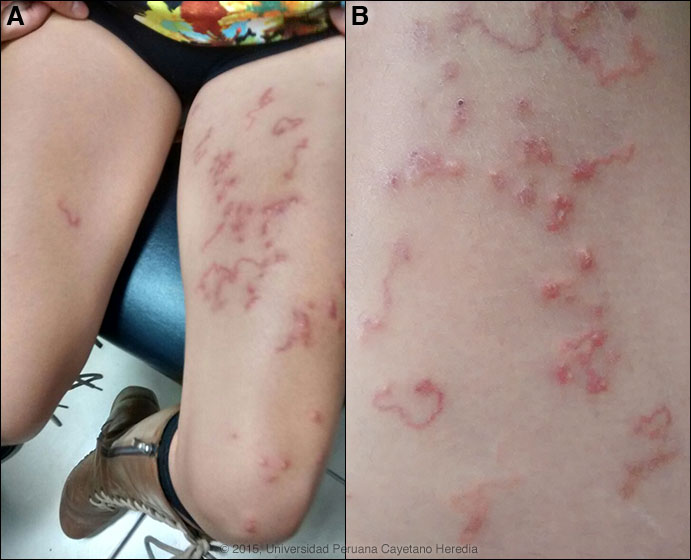
|
Gorgas Case 2015-09 |

|
|
This is our last Case of the Week for 2015. Publishing these case reports would not be possible without the assistance of an extremely dedicated group of people. We would like to thank in particular: Dr. Carlos Seas, Clinical Rounds Coordinator for
the Gorgas Courses, for case selection and coordination of case summaries and images, and Adam Plier of the Gorgas Center for Geographic Medicine in the UAB Division of Infectious Diseases for all publishing on the Gorgas Course website.
We hope you have enjoyed the 2015 series of live cases each week from Perú. The Gorgas Diploma Course is held annually in February and March and we will be in touch at the beginning of next year’s case series. David O. Freedman & Eduardo Gotuzzo
Course Directors |
|
Gorgas Advanced Course participants saw this patient at the UPCH Dermatology Clinic. We would like to thank Gorgas Dermatology Professor Dr. Francisco Bravo.
History: 28 year-old female with an 11-day history of a pruritic maculo-papular eruption on her left thigh which had been preceded by pruritus only. The symptoms started in Bogotá, Colombia on the fifth day of a vacation; she had stayed in Cartagena briefly then spent 4 days sunbathing at a nearby beach. She took loratadine and the itching stopped but 3 days before presentation the lesions became red and increased in size. She has no relevant past medical history, no allergies, and is currently not taking any medication. Epidemiology: Born and lives in Lima. She is a veterinarian. Travel includes visits to Chile 4 months earlier, to Trujillo, Perú 2 months earlier, and to Mexico 1 month earlier. Physical Examination: Multiple erythematous papules with serpiginous tracks on her right thigh, lower abdomen, and inner aspect of her right thigh [Images A and B]. The rest of the examination was unremarkable. 
 |
|
Diagnosis: Hookworm-related Cutaneous Larva Migrans due to Ancylostoma braziliense.
Discussion: This is a clinical diagnosis with pathognomonic clinical findings as demonstrated in the Images. Hookworm-related cutaneous larva migrans, is the term that describes the characteristic migratory dermatitis caused by initial invasion of the skin by the larva of animal or human nematodes. The larvae of the dog and cat hookworm Ancylostoma braziliense account for almost all of the clinically obvious skin lesions. Other hookworms infecting animals can invade and parasitize humans or can penetrate the human skin (causing hookworm-related cutaneous larva migrans), but do not develop any further (Ancylostoma caninum, Uncinaria stenocephala). Occasionally A. caninum larvae may migrate to the human intestine, causing eosinophilic enteritis. Because Ancylostoma braziliense does not mature or complete its life cycle in humans, the immature larvae may wander superficially for up to several months before their spontaneous death. The larvae move up to 1-2 cm per day. Biopsy of the lesions is not recommended, as the larvae are rarely isolated. Usually the larvae have migrated ahead of any inflammatory response and it is difficult to know in what direction the larva has advanced. Cutaneous larva migrans is found in any moist warm climate and is found in the southeastern USA as well as throughout the tropics. Larvae of human hookworm (Ancylostoma duodenale and Necator americanus) may cause an initial pruritic lesion but rarely migrate in the skin before traveling to the lung and then the intestine as they mature and complete their life cycle. Other causes of the clinical syndrome of creeping eruption include gnathostomiasis [see example in Gorgas Case 2003-01], which tends to cause more hemorrhagic and less distinct linear tracks, and strongyloidiasis, which causes a variant usually called larva currens. Larva currens occurs due to autoinfection whereby filariform larvae of Strongyloides stercoralis passed in the stool invade perianal skin and re-infect the same host. The lesions are usually in the perianal, buttock, or abdominal region only. The lesions are highly pruritic but have a predominant urticarial component and progress up to several cm per day. They may be present for several weeks. The subcutaneous filarial infection with Loa loa seen in west and central Africa causes a migratory and transient angioedema, predominantly around joints. Linear lesions are not found. Treatment is with ivermectin 12 mg PO, which can be repeated once a day later, or with albendazole 400 mg PO for 3 days. Most clinicians prefer ivermectin [Clin Infect Dis. 2013 Oct;57(8):1155-7]. Thiabendazole topical therapy still mentioned in many textbooks is no longer used and cryotherapy still used by some dermatologists is much less effective. Because of the fecal origin of the larvae, bacterial superinfection can result but antibiotics are generally only recommended if purulent infection is clinically present. Our patient received ivermectin and after one week the lesions were drying and healing though mild pruritus remained.
|